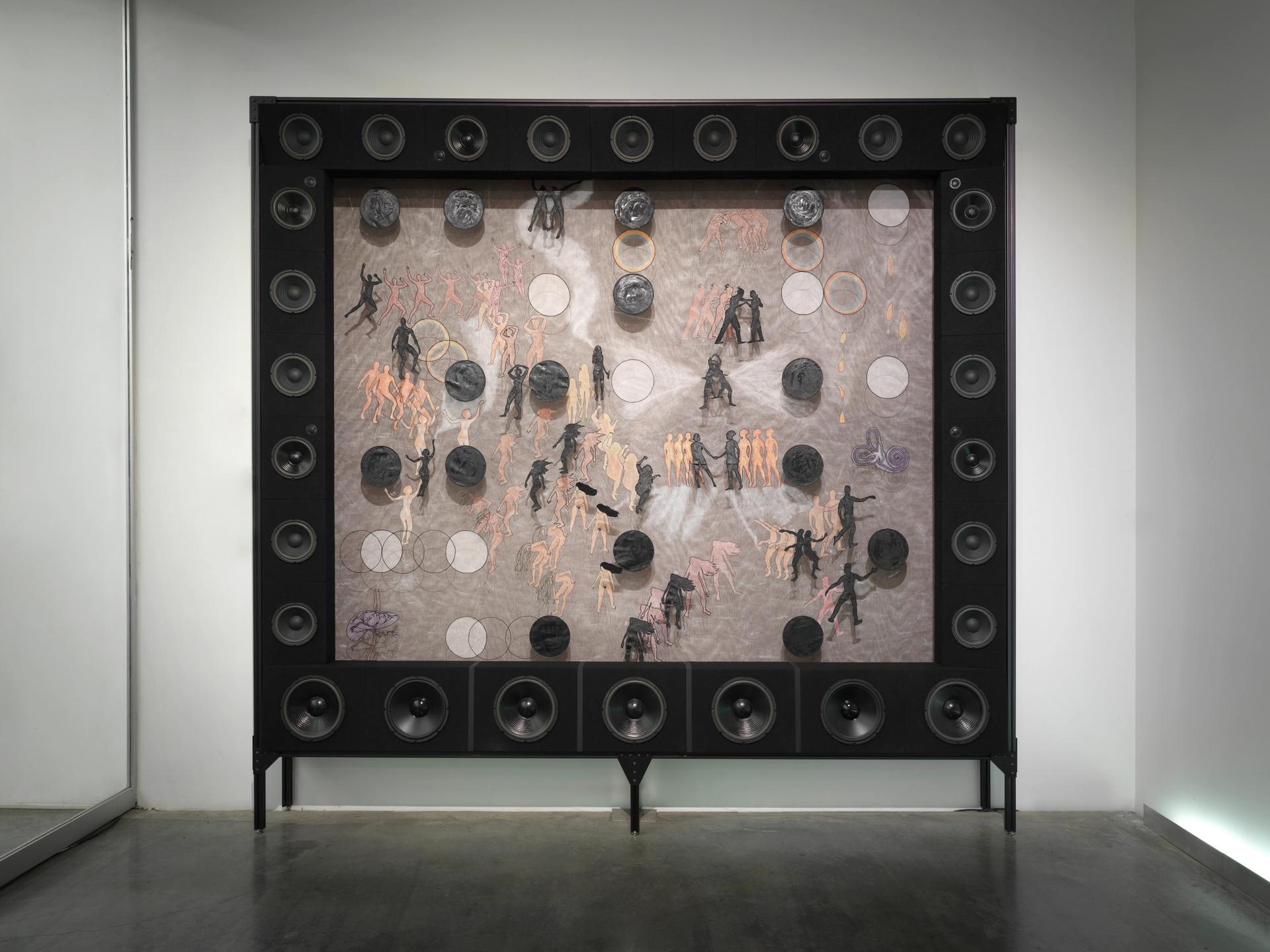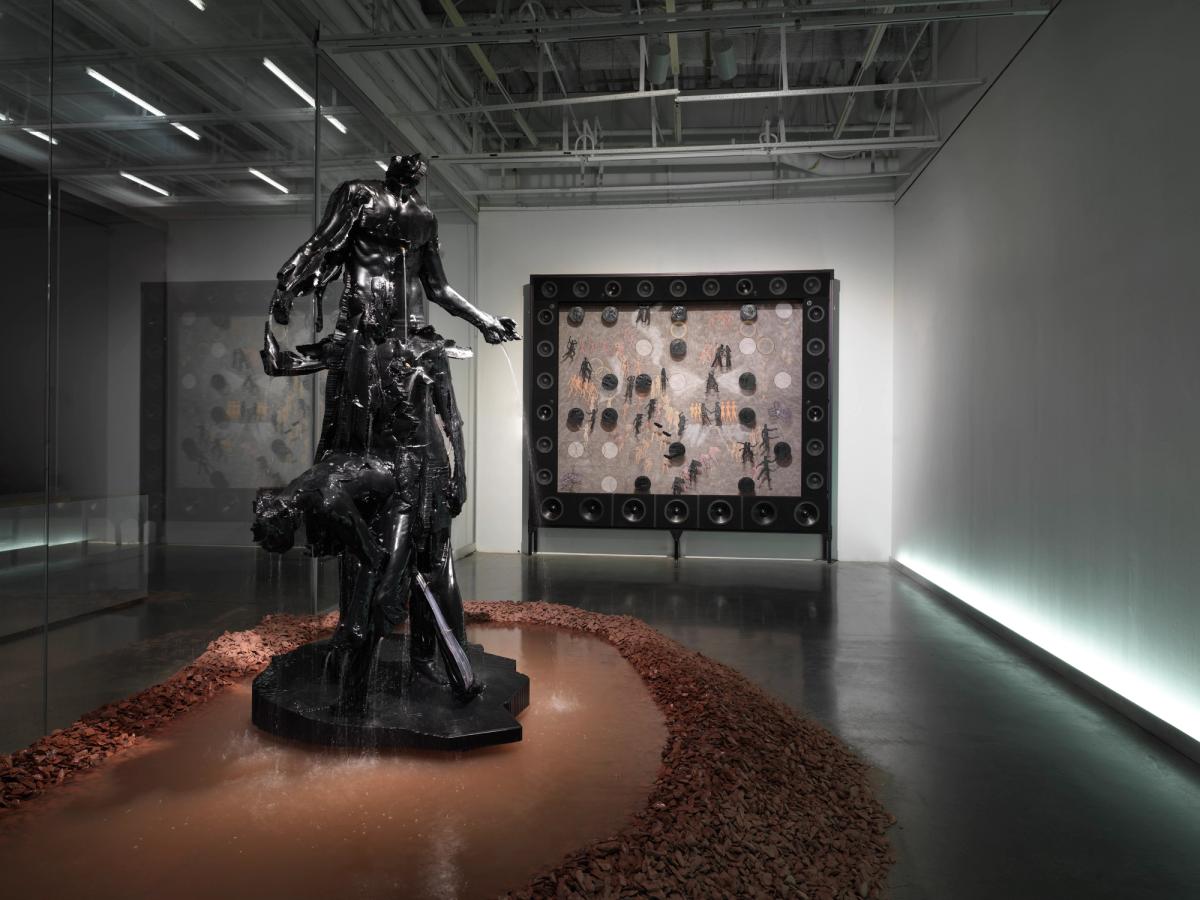Vibration is a force of nature—largely uncharted artistically, it is a reminder of corporal magnitude and internal radiance. The idea of vibrational alchemy prompted Bernardo Mosqueira, a curatorial fellow at the New Museum, to tap the Rio de Janeiro-based mixed-media artist Vivian Caccuri and the New York-based performance artist Miles Greenberg to merge forces for a joint exhibition that explores alternative methods of capturing vibration and movement, titled The Shadow of Spring (until 5 February 2023) and on view in the museum’s lobby gallery.
“Our approaches to the body are so different, but the commonality in our works is an interest in motion,” Greenberg says, reflecting on the project's development during months of online meetings. “Our geographic distance shaped the way we think together—if we lived in the same city, this would not be the same show,” Caccuri adds.

Installation view of Vivian Caccuri and Miles Greenberg: The Shadow of Spring at the New Museum, New York. Photo: Dario Lasagni. Courtesy New Museum.
In addition to capturing her own body’s sounds (with the help of a doctor), Caccuri recorded echoes of Greenberg’s lungs and skin after ten-minute workouts through a digital stethoscope. The sonic heft of the show’s titular, 35-minute sound installation (2022) blends into the titillation of fleeting movements captured in Caccuri’s embroideries of contorted bodies over mosquito nets and Greenberg’s fragmented urethane sculptures that replicate his seven-hour performance, Fountain I, at Worthless Studios in Brooklyn earlier this year. The amplified sounds emanate from the artists’ respiratory and perspiratory reactions, while the sculptures respond to Mosqueira’s invitation to explore vibration with tactility.
“The sounds from inside and outside of the artists’ bodies make us vibrate together,” the curator says. The show’s sensory multitude finds its footing in Vessel Flame and Vessel Body (both 2022), Caccuri’s embroideries, in which soft threads penetrate the punctured netting. Hairs flipped and arms bent, the woven gestures stem from the artist’s photographs of dancers at the parties she throws at her studio. The bodies’ repetition over the mesh surface strives to embody the partygoers’ delirious movements in reaction to the beats oscillating between paced down rhythms and booming spirals.
“Bodies’ patterns change with the way I DJ; they move their hips or other times their shoulders with each new track,” Caccuri says.

Installation view of Vivian Caccuri and Miles Greenberg: The Shadow of Spring at the New Museum, New York. Photo: Dario Lasagni. Courtesy New Museum.
While Caccuri’s handmade sound system creates what she calls “the altar effect” at her studio by pulling people together, divinity and worship spill into the show through Greenberg’s embodiment of endurance and devotion. The artist—best known for executing physically demanding performances over many hours—has stripped his physical presence from the show to create fountain-like sculptures activated by water.
Greenberg manufactured Mars and Janus (both 2022) at the New Jersey-based foundry Digital Atelier in high density urethane, which is commonly utilized for creating mold positives for bronze casting. “One hundred years from now, the sculptures could be used to make bronze pieces, so they are never fully finished; their material is in a state of constant motion,” he says.

Installation view of Vivian Caccuri and Miles Greenberg: The Shadow of Spring at the New Museum, New York. Photo: Dario Lasagni. Courtesy New Museum.
The sculptures are based on one of Greenberg’s former performances, in which he stood over a plinth and got drenched by a sanguine liquid. The sculptures feature glitches as a result of the 3D scanning technology. In contrast to the artist’s elegantly determined posture, the sculptures’ torsos and limbs appear elongated, bent, thinned or oozing. They record a bygone performance’s ethereal memory.
- The Shadow of Spring, until 5 February 2023 at the New Museum, New York


